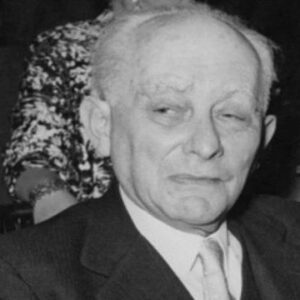Max Born was a German scientist who made significant contributions to the development of quantum mechanics. Throughout his career, he also contributed contributions to solid-state physics and oversaw the work of other eminent physicists. Born, like many other prominent German thinkers, was forced to flee the country during the Nazi occupation. He is also well-known for being a friend and collaborator of Albert Einstein. Born and Walter Bothe were jointly awarded the Nobel Prize in Physics for their statistical interpretation of the quantum theory, particularly the wave function. Throughout his early and mid-career, the erudite scientist struggled for recognition. Despite his consistent advances in mathematics and physics, he was underappreciated by peers and overshadowed by others. He was often associated with exceptionally gifted mathematicians, including Einstein and Heisenberg. Additionally, he was regularly chastised by his peers for his work in quantum theory, which was a commonly shunned subject at the time. Despite the fact that his work is not as well-known as that of his contemporaries, Born was a significant mathematician whose contributions helped shape quantum physics into what it is today. Continue reading to learn more about this prominent physicist’s life and scientific contributions.
Childhood and Adolescence
Max Born was born in Breslau, Germany, on December 11, 1882, to Gustav Born and Margarethe Kaufman. His father was a physician who specialized in anatomies and embryology.
Max Born entered the ‘University of Breslau’ in 1901, at the age of nineteen.
Born enrolled at the ‘University of Gottingen’ after three years at the ‘University of Breslau’. He meets three eminent mathematicians at Gottingen: David Hilbert, Felix Klein, and Hermann Minkowski.
Born quickly rose to the position of personal assistant to David Hilbert, transcribing his lectures. He quickly built close relationships with both Hilbert and Minkowski, who frequently met for Sunday dinner.
Max Born’s Career
After getting his Ph. D. in mathematics at Gottingen in 1906, he briefly served in the army.
Born served six months in the army before getting discharged due to a severe asthma episode. He was then re-enlisted and promptly discharged six weeks later due to another asthma episode.
Born became acquainted with Albert Einstein’s work on special relativity in 1907 and began collaborating with Minkowski on special relativity shortly thereafter. Minkowski died before they had the opportunity to report their findings to the ‘Gottingen Mathematics Society.’
In 1909, Born presented his findings to the ‘Gottingen Mathematics Society’ without the assistance of Minkowski. He encountered considerable opposition but was encouraged to continue his investigation by his peers.
In 1915, he co-authored ‘Dynamic der Kristall-Gitter,’ or ‘The Dynamical Theory of Crystal Lattices,’ with Kun Huang. The book established the fundamental principles of mineralogy and crystallography.
In 1923, he published “Die Relativitiitstheorie Einsteins und Hire Physikalische Grundlagen,” a seminal book that had a significant influence on quantum mechanics. Einstein personally lauded the writings.
In 1933, he relocated from Germany to England to teach at a university. He taught briefly at ‘Oxford’ and ‘Cambridge’ before accepting a position at the ‘University of Edinburgh’.
Max was awarded the 1934 ‘Stokes Medal of Cambridge,’ which recognizes individuals who have made major contributions to analytical chemistry. This was one of the earliest honors bestowed upon him, signaling the beginning of Born’s rise to prominence in the English scientific community.
In 1935, Born wrote ‘Atomic Physics,’ which established the field of atomic physics, as well as ‘The Restless Universe,’ an accessible introduction to the world of quantum mechanics.
In 1939, he was elected a fellow of the ‘Royal Society,’ one of the world’s oldest and most renowned scientific societies.
In 1943, he wrote ‘Experiment and Theory in Physics.’ ‘Experiment and Theory in Physics’ established standard operating protocols for physics experiments.
In 1949, while working at ‘Oxford University,’ Born wrote ‘A General Kinetic Theory of Liquids and ‘Natural Philosophy of Cause and Chance. These are two of his final papers, which laid the groundwork for kinetic theory.
Honors and Commendations
In 1945, Born was awarded the ‘MacDougall–Brisbane Medal’ by the ‘Royal Society of Edinburgh.
In 1954, the pioneering scientist received the ‘Nobel Prize in Physics for his work in quantum mechanics, particularly his statistical interpretation of the wave function.
His Significant Works
Max Born pioneered the statistical interpretation of quantum physics. His wave function theories were crucial in the development of quantum theory, and he was even given a Nobel Prize for his work.
Personal History and Legacies
On August 2, 1913, Max Born married Hedwig Ehrenberg and the pair had three children, a son, and two daughters.
The visionary physicist died on January 5, 1970, and was buried in Gottingen’s City Cemetery.
In 1972, the ‘German Physical Society’ and the British Institute of Physics established the ‘Max Born Prize.
Erwin Schrodinger defined quantum mechanics in terms of Born’s wave equation.
Estimated Net worth
Max is one of the wealthiest mathematicians and is included on the list of the most popular mathematicians. Max Born’s net worth is estimated to be $1.5 million, based on our analysis of Wikipedia, Forbes, and Business Insider.


